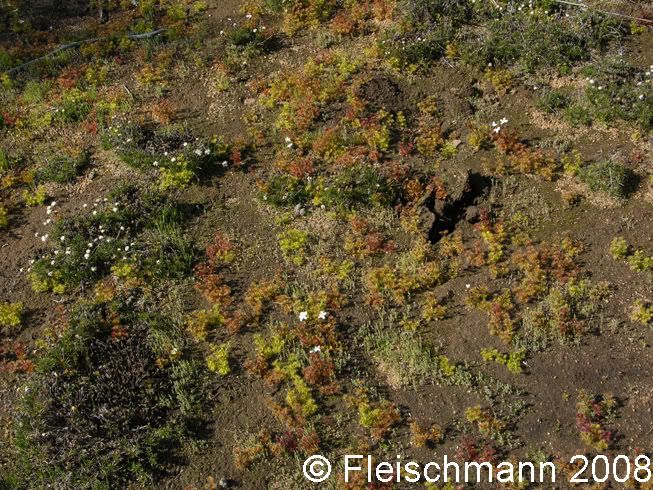Post by andreasfleischmann on Dec 21, 2008 17:29:14 GMT
G’day mates! 
During my 3 weeks tour botanising Western Australia, the Drosera stolonifera-complex (or „the stolonifera-gang“, as Allen Lowrie would refer to ) was most impressive and fascinating in my opinion. Especially because every species of that complex seem to have its own inhabitants.
) was most impressive and fascinating in my opinion. Especially because every species of that complex seem to have its own inhabitants.
Let’s start with the most variable species: Drosera rupicola (AKA D. stolonifera ssp. rupicola).

Drosera rupicola („the rock-dwelling Drosera“) grows in arid regions on clay soils over granitc rock. It’s most commonly found at the edge of flat granitic outcrops (“inselbergs”), which act like drainage lines during the rainy season, and which form shallow pools that store water. That’s why these granitic outcrops are perfect CP habitat in the drier parts of South-Western WA.

Drosera rupicola forms huge populations at some locations. This species occurs in three different colour morphs („yellowish green“, „orange“ and „dark red maroon“), which usually grow together in mixed populations.





„Drosera traffic lights“

The sweetly parfumed flower of D. rupicola last for several days (up to 4 or 5 days in plants in my greenhouse! That’s the most long-lasting Drosera flowers I know of! The limit in D. cistiflora and relatives is three days). I observed that flies were acting as pollinators at that special location.

What did attract my attention most were not the sundews alone, but the mirid bugs of genus Setocoris, which live on most Australian Drosera growing on lateritic soil (but on a few species occurring on sandy soils, too).
Different place and different Drosera host usually means different sundew bug as well! There are lots of undescribed Setocoris species on various Drosera. However, species identification in true bugs is really difficult, especially in Miridae, as you need to study the male genitals to tell the species apart.
Most species of Setocoris you will encounter in Australia are still undescribed species!

Setocoris spec. ‚A’ on D. rupicola. Those bugs feed both on the prey that is caught by the plant, as well as on the plant itself (just like Pameridea bugs do on Roridula). These sundew bugs can fly really well, and they disappear at the slightest movement or shadow they note – either by falling from the plant and hiding between the basal leaves, or they just fly away. And I observed that these „sundew bugs“ are not restricted to Drosera only, but thrive well on other plants, too. And there might be more than one single species living on the same host plant.
However little is known yet on the habits and ecology of these interesting sundew inhabitants.

All the best,
Andreas

During my 3 weeks tour botanising Western Australia, the Drosera stolonifera-complex (or „the stolonifera-gang“, as Allen Lowrie would refer to
 ) was most impressive and fascinating in my opinion. Especially because every species of that complex seem to have its own inhabitants.
) was most impressive and fascinating in my opinion. Especially because every species of that complex seem to have its own inhabitants.Let’s start with the most variable species: Drosera rupicola (AKA D. stolonifera ssp. rupicola).

Drosera rupicola („the rock-dwelling Drosera“) grows in arid regions on clay soils over granitc rock. It’s most commonly found at the edge of flat granitic outcrops (“inselbergs”), which act like drainage lines during the rainy season, and which form shallow pools that store water. That’s why these granitic outcrops are perfect CP habitat in the drier parts of South-Western WA.

Drosera rupicola forms huge populations at some locations. This species occurs in three different colour morphs („yellowish green“, „orange“ and „dark red maroon“), which usually grow together in mixed populations.





„Drosera traffic lights“


The sweetly parfumed flower of D. rupicola last for several days (up to 4 or 5 days in plants in my greenhouse! That’s the most long-lasting Drosera flowers I know of! The limit in D. cistiflora and relatives is three days). I observed that flies were acting as pollinators at that special location.

What did attract my attention most were not the sundews alone, but the mirid bugs of genus Setocoris, which live on most Australian Drosera growing on lateritic soil (but on a few species occurring on sandy soils, too).
Different place and different Drosera host usually means different sundew bug as well! There are lots of undescribed Setocoris species on various Drosera. However, species identification in true bugs is really difficult, especially in Miridae, as you need to study the male genitals to tell the species apart.
Most species of Setocoris you will encounter in Australia are still undescribed species!

Setocoris spec. ‚A’ on D. rupicola. Those bugs feed both on the prey that is caught by the plant, as well as on the plant itself (just like Pameridea bugs do on Roridula). These sundew bugs can fly really well, and they disappear at the slightest movement or shadow they note – either by falling from the plant and hiding between the basal leaves, or they just fly away. And I observed that these „sundew bugs“ are not restricted to Drosera only, but thrive well on other plants, too. And there might be more than one single species living on the same host plant.
However little is known yet on the habits and ecology of these interesting sundew inhabitants.

All the best,
Andreas









